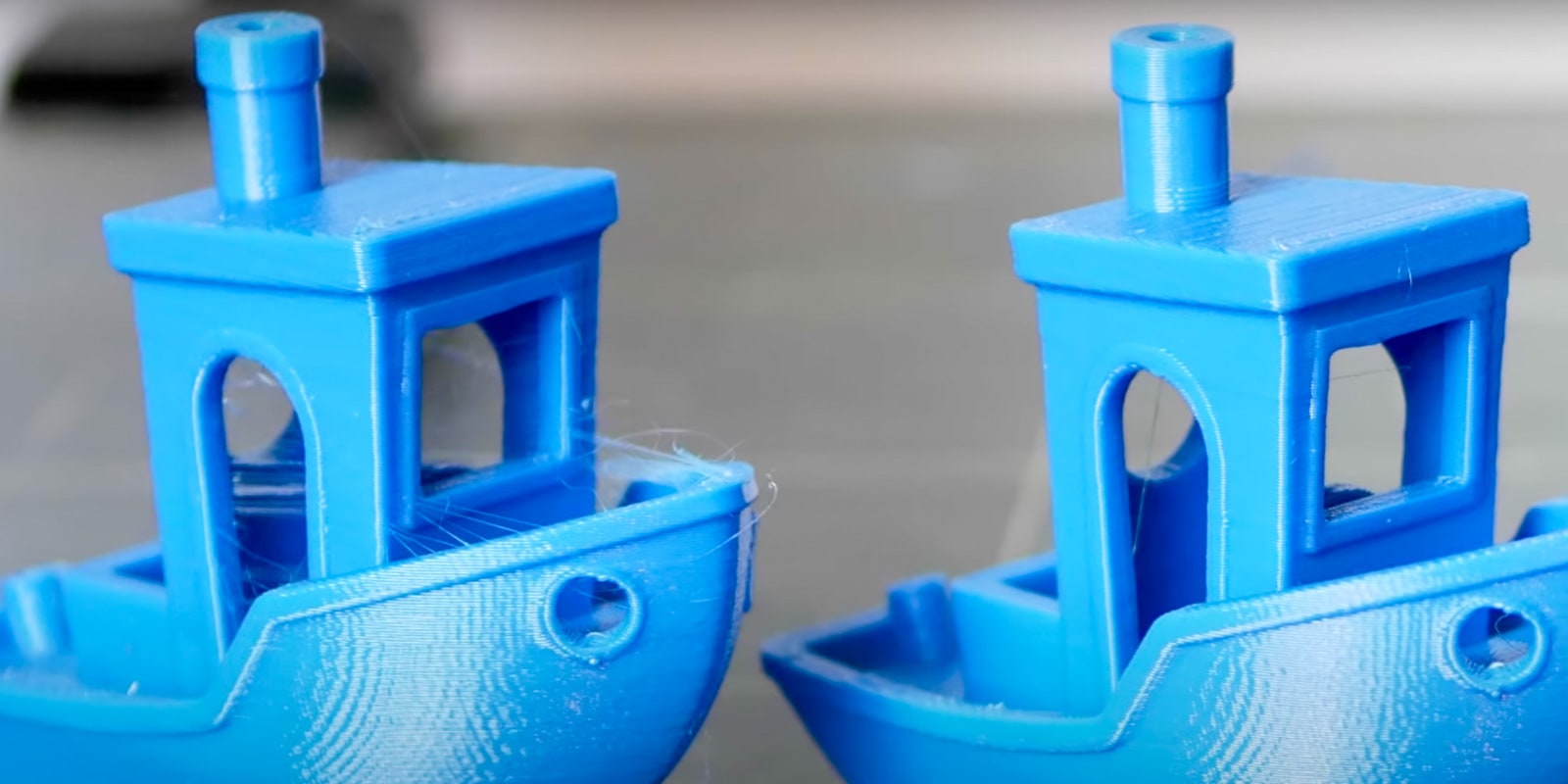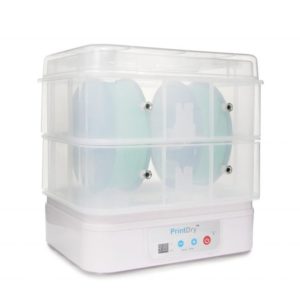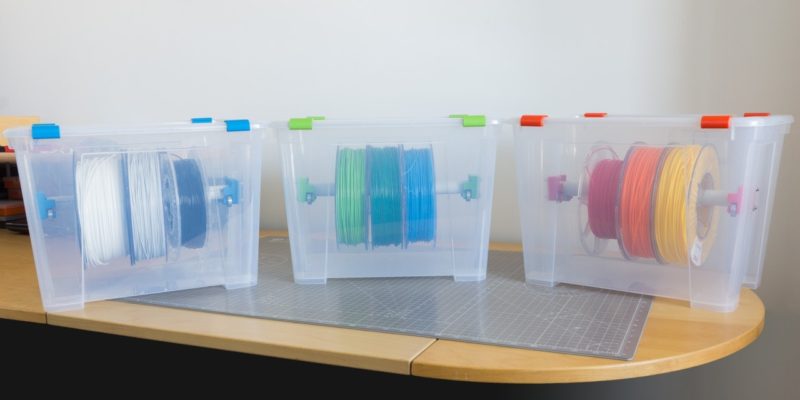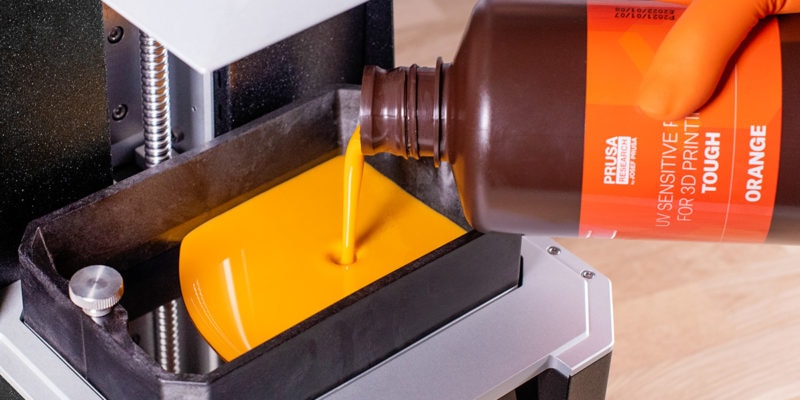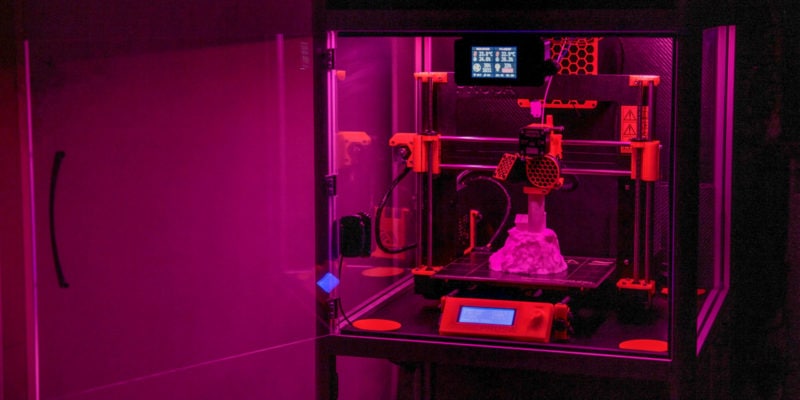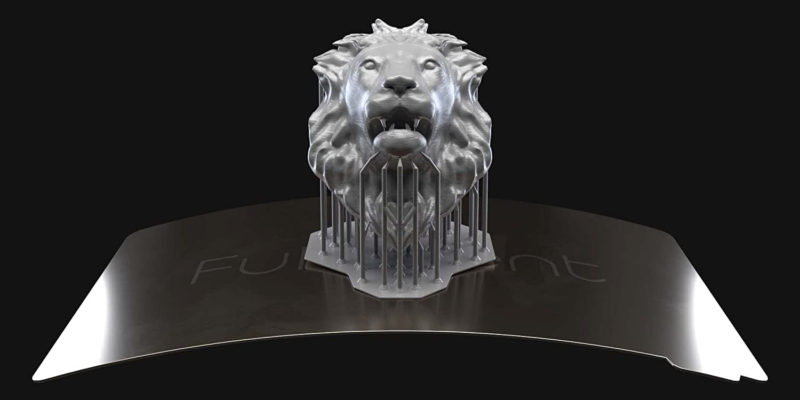For how much thought we put into choosing the right filaments for 3D printing, we often don’t take very good care of them once we have them. If you’ve ever used an old roll of PLA filament or gotten a spool that just didn’t seem to print right, you likely already know that filaments left out in the air will lose quality over time. That’s because many filaments are moisture sensitive and need to be stored in airtight containers.
In this article, we’re going to jump right into teaching you how to store your moisture-sensitive materials like TPU, PETG, Nylon, and PLA filament properly to keep moisture out of them, how to fix filaments that have already absorbed too much water, and point you toward the products that can help you keep your filaments 3D printing smoothly for as long as possible.
| Filament Storage | Capacity | Hygrometer | Heating | Price | Best Offer |
|---|---|---|---|---|---|
| Sovol SH01 Filament Dryer | 2 spools | Yes | Yes | $63 | |
| PrintDry Drying System | 4 spools | Yes | Yes | $189 | |
| SUNLU Dryer Box | 1 spool | Yes | Yes | $50 | |
| Polymaker PolyBox II | 2 spools | Yes | No | $66 | |
| Ruggard Dry Cabinet | 30L (many spools) | Yes | Yes | $150 | |
| PrintDry Vacuum System | 5 x 1 spool | No | No | $110 | |
| Repkord RepBox 2.3 | 6 spools | No | No | $225 | |
| Comgrow Storage Box | 2 spools | Yes | Yes | $62 | |
| EIBOS Filament Dryer | 1 or 2 spools | Yes | Yes | $59/$153 | |
| Wisedry Silica Gel | N/A | N/A | N/A | $30 |
Why is It Important to Keep Filament Dry?
Water-sensitive 3D printing materials like TPU and PLA filament need protection from moisture in order to be 3D printed without problems. They absorb moisture from their environment (including moisture from the air) and degrade in quality when they are left out in the open. PLA filament in particular is known for this, but Nylon and PETG are prone to this as well.
Not only does wet filament cause significant print quality issues like uneven extrusion and bubbling, but it can also cause mechanical problems in your printer. Wet filament can lead to wear on your nozzle, and introduce clogs and jams. These are just a few of the reasons why keeping your 3D printer filament dry should be a major priority.
Signs of Wet Filament
While wet filament usually doesn’t appear any different than dry filament while on the spool, there are a few major indicators that your 3D printing filament has absorbed moisture.
Brittleness
One of the easiest ways to check if your filament has taken on excess moisture is to check for brittleness. Healthy PLA filaments don’t snap when you bend them. The PLA filament strand should bend back and forth several times without breaking. If your filament (or, as is usually the case, certain parts of it) snap in two when bent, moisture is the most likely culprit.
This can cause a lot of issues during the printing process. Your filament can snap mid-print, and if your 3D printer doesn’t have a filament sensing feature, your print will fail. It’s also easy for the filament to get jammed in the extruder during a filament change, so that is a possibility as well when you have to feed the end of the filament into the printer again.
Print Quality
If your filament bubbles, pops, or hisses while printing, your spool has most likely absorbed too much moisture. As the water in the filament heats up in the hot end, it vaporizes. The bubbles and popping are from that vapor trying to escape. This not only leaves unsightly holes in or bulges in your prints, but it also leads to uneven extrusion and stringing.

Now let’s look at the best filament storage solutions that keep your filament dry!
Best 3D Printer Filament Storage and Dryers in 2022
The Sovol SH01 Filament Dryer is a fantastic storage and drying solution for 3D printing filaments. With a capacity for two filament spools, you can easily swap between colors or feed to two printers at a time.
The box features two PTFE outlets in the lid that allow you to print with your filament while it is in the box. You can also close the outlets during the drying process or when storing your filament spool for an extended time.
This dryer features electronic heating, drying, and a humidity sensor with a real-time display. This allows you to dry out and salvage filament spools that have already absorbed moisture and need it removed or to ensure that a new roll of filament is completely dry before using it for the first time.
The Sovol SH01 also has an offline mode that lets you store 3D printer filament for long periods of time when they are not in use. Adding a desiccant packet to the box and sealing it turns the box into an airtight container that will keep your filament free from moisture.
Technical Details |
|
|---|---|
| Capacity | 2 spools |
| Humidity Monitoring | Yes |
| Heating | Yes |
| Filament Diameters | 1.75 mm, 2.85mm |
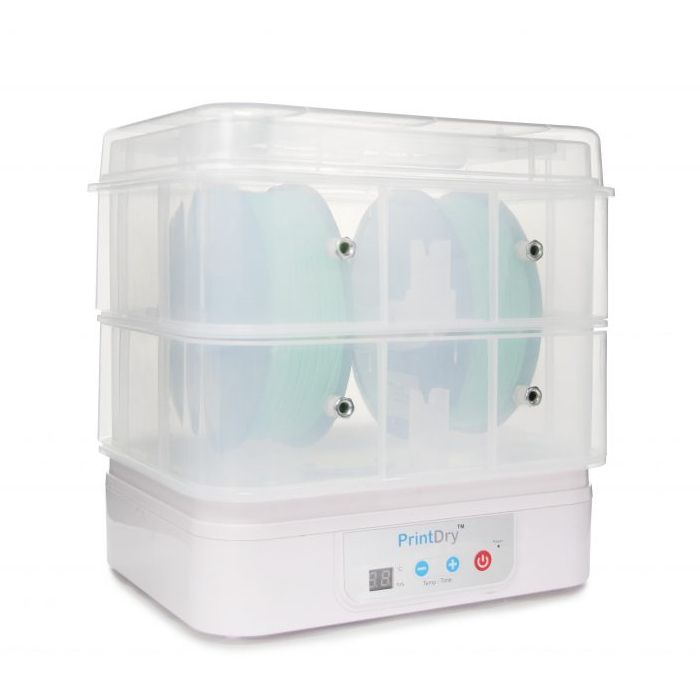
The PrintDry PRO is a sophisticated system that allows you to dry and/or store a variety of filament spools. With preset drying profiles for common hygroscopic 3D printing materials like Nylon, PETG, PVA, PLA, and TPEs that set the ideal temperature, humidity, and time intervals for the type of filament in question.
It is set up to hold 4 regular-sized filament spools at a time with PTFE outlets to print the filament while it is inside the box. You can also purchase a separate kit to hold one large spool instead (up to 5kg) if you regularly use oversized spools.
Its digital display and buttons on the front make it easy to navigate through the features and set the controls to the desired temperatures and times. This unit also has a built-in humidity monitor, making it easy to keep track of moisture levels within the box.
Technical Details |
|
|---|---|
| Capacity | 4 regular spools or 1 large spool (up to 5kg) |
| Humidity Monitoring | Yes |
| Heating | Yes |
| Filament Diameters | 1.75mm, 2.85mm, 3mm |
For an affordable and high-quality storage option and dryer, the SUNLU Dry Box is an excellent choice. It not only lets you set custom temperature and humidity levels, but it also is equipped with a 6-hour automatic shut-off.
This dryer box can support one spool at a time, and it has a filament outlet and rollers that allow your filament to smoothly feed to your printer from inside the box. This is an excellent upgrade for a spool holder, giving you the option to dry excess moisture from a filament spool or to keep it from absorbing moisture in between uses.
You can also set your own drying times for spools that need more or less drying than the box’s default settings for a maximum of 24 hours.
Technical Details |
|
|---|---|
| Capacity | 1 spool |
| Humidity Monitoring | Yes |
| Heating | Yes |
| Filament Diameters | 1.75mm, 2,85mm, 3mm |
If you are looking for a basic 3D printer filament storage box with a measurable humidity level, Polymaker’s PolyBox is a great option. With a built-in measuring device, you can keep an eye on both the temperature and humidity level within the box without needing to keep it plugged in.
In fact, the PolyBox is a low-energy storage option that does not use electronic heating elements or dehumidifiers. Instead, the box comes with a reusable desiccant bag that can keep the inner humidity levels below 15%.
It has outlets built into the lid to let you print with the filaments while they are in the box. It also comes with tubing that connects to the outlets and keeps the filament safe on its way from the box to the extruder. However, it is medical tubing rather than PTFE tubing typically used in 3D printing, so it doesn’t feed to the printer quite as smoothly.
Technical Details |
|
|---|---|
| Capacity | 2 1kg spools or 1 3kg spool |
| Humidity Monitoring | Yes |
| Heating | No |
| Filament Diameters | 1.75mm, 2.85mm |
Marketed as a dehumidifying cabinet for photography equipment, electronics, and other moisture-sensitive items, the Ruggard Electronic Dry Cabinet is a sophisticated dehumidifier that has a locking door, two-shelf interior, and electronic display that allows you to monitor the inside temperature and humidity. The unit is quiet, dripless, and able to keep the relative humidity (RH) between 35 and 60%.
This product is a great solution for users with large quantities of filament that need a long-term storage method.
The one downside of this product is that it is not designed with 3D printer filament in mind, so there are no outlets to print while drying. Since the unit has two shelves, it is a great option to keep several excess filament spools dry in tandem with one of the other dryer options for the filament spool actively in use.
Technical Details |
|
|---|---|
| Capacity | 30L (many spools) |
| Humidity Monitoring | Yes |
| Heating | Yes |
| Filament Diameters | N/A |
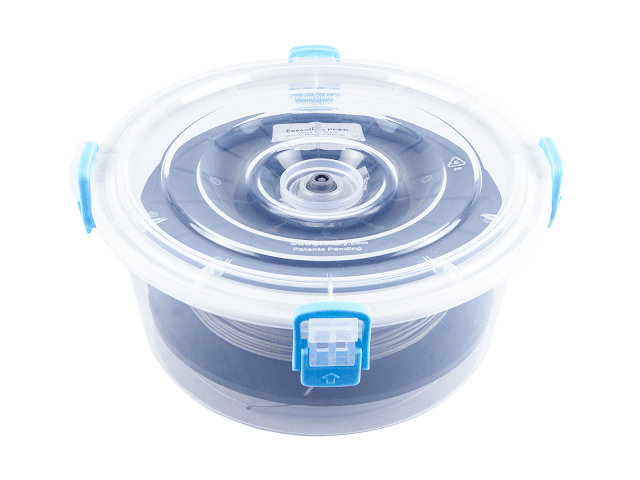
Using a manual storage solution similar to that of food and produce storage, the PrintDry Vacuum Sealed Filament Storage System is a set of five round plastic containers that are large enough to fit most standard spool sizes. Each container can fit one spool and has a hole in the lid that allows you to pump out any air from the container with the included hand pump.
The manufacturer suggests putting silica gel desiccant packets and humidity indicator cards in the containers with the filament to help reduce moisture and measure the humidity levels in the container over time. They also suggest using the pump once a week to remove any moisture that may have entered the containers over time and lengthen the shelf life of your filament.
The PrintDry filament storage container system is for 3D printing filament spools that are not currently in use, and don’t have any outlets to allow printing from the container. The containers are also quite expensive for their functionality, so while they are a good storage method, they are not practical for users with large quantities of filament, especially cheap rolls of PLA filament.
Technical Details |
|
|---|---|
| Capacity | 1 spool per container (5 containers per set) |
| Humidity Monitoring | No |
| Heating | No |
| Filament Diameters | N/A |
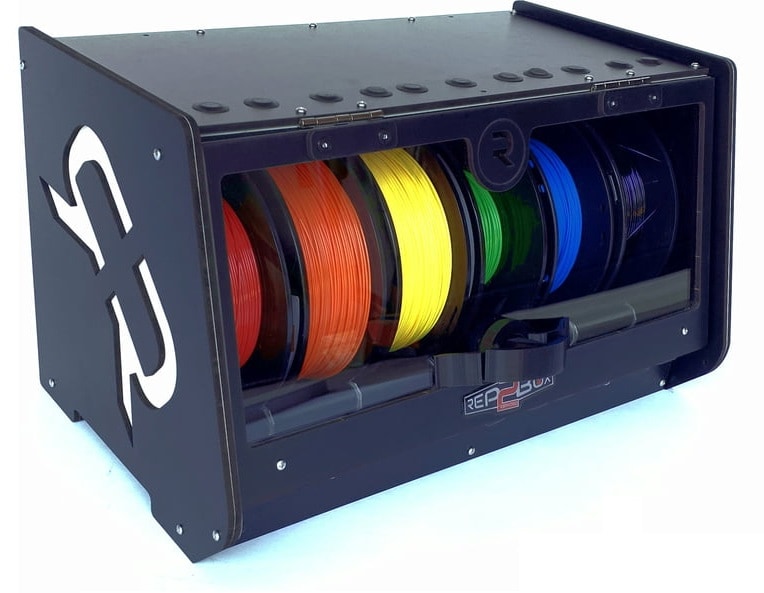
For an easy storage solution for multiple spools, the Repkord RepBox 2.3 is a simple but effective 3D printing filament management system that keeps your spools organized, accessible, and provides some protection against moisture. Able to accommodate several spools, the Repbox is perfect for users with a large assortment of filaments that they switch frequently.
The RepBox is not a dry box, meaning it does not actively remove moisture and maintain a set environment. It is essentially a multi-spool holder that keeps out most moisture using airtight seals and gaskets. However, there is an optional upgrade kit to add a dehumidifier for drying filament as well.
The box has several outlets for the filament to feed into the printer while in storage and uses rollers to keep the filament feeding smoothly into the printer. You can also mount the box beside or above the printer with the included bracket set to keep your filament out of the way but easily accessible to your 3D printers.
Technical Details |
|
|---|---|
| Capacity | 6 spools |
| Humidity Monitoring | No (Upgrade Kit Available) |
| Heating | No |
| Filament Diameters | 1.75mm, 2.85mm |
Another versatile choice for 3D printer filament storage, the Comgrow box works as both a traditional filament dryer and long term filament storage solution. Its dry box function lets you adjust the temperature and time duration for the drying process, as well as keeps a constant measure of the relative humidity in the box.
It has two PTFE outlets that let you use the filament for 3D printing even while the dryer is running, making it perfect for keeping your TPU, PETG, or PLA filament at optimal performance. Its heating element also gets to the desired temperature quickly and distributes the heat evenly, so even if your 3D printer filament absorbs moisture, it will be dry in a few hours.
With an airtight silicone seal, you can use the Comgrow box as a storage container for your dry filaments. Adding a desiccant like silica gel packets will keep your filament free of water for months between uses.
Technical Details |
|
|---|---|
| Capacity | 2 spools |
| Humidity Monitoring | Yes |
| Heating | Yes |
| Filament Diameters | 1.75mm, 2.85mm, 3mm |
The EIBOS filament dryer is another great option for 3D printer filament storage and drying. Available as a single or double dry box, you can choose the size that best suits your needs since both models have the same features. With a heating element twice as powerful as normal filament dryers, the EIBOS box heats up quickly and uses fans to make sure all the air circulates evenly.
The EIBOS dryer also features a real-time humidity gauge, so you can always be sure that your 3D printer filament has the low humidity environment that it needs.
Like the other dryer boxes featured on this list, you can use it as a long-term filament storage container. Adding some desiccant beads after the drying process will help with keeping the filament safe from moisture from the air and extend its shelf life between dryings.
Technical Details |
|
|---|---|
| Capacity | 1-2 spools |
| Humidity Monitoring | Yes |
| Heating | Yes |
| Filament Diameters | 1.75mm, 2.85mm, 3mm |
Wisedry Silica Gel Desiccant Beads are an economical choice for keeping moisture away from your filaments, whether you store filament in vacuum storage bags, storage boxes, dry cabinets, or a simple airtight box. Unlike the disposable desiccants you find in packets, Wisedry is a reusable silica gel that can be put in the oven or microwave to dry out.
When it can’t absorb more moisture from the air, it turns yellow to let you know it needs to be refreshed. Once it has dried out again in the oven or microwave, you can put it back in your filament storage container to keep absorbing moisture.
Technical Details |
|
|---|---|
| Capacity | N/A |
| Humidity Monitoring | N/A |
| Heating | N/A |
| Filament Diameters | N/A |
DIY Filament Drying Boxes
If you don’t want to buy a 3D printer filament storage system, there are several ways you can make your own or use what you have around the house.
Food Dehydrator
If you have a food dehydrator in your kitchen, you’re in luck. These versatile appliances are good for more than just making jerky. They can also be used as a basic dryer to remove moisture from your filament.
Because dehydrators work at a very low temperature, they are suitable for drying all filament types, including temperature sensitive materials like PLA filament. Some users even modify theirs to make them easier to use for filament storage and drying.

Vacuum Sealers
Much like the PrintDry Vacuum Sealed System, the special vacuum bags used to keep food fresh can also be used to store filament. The special plastic bags have a spot where air can be pumped out, removing any moisture that the filaments might absorb. Putting silica gel and humidity indicator strips in the vacuum bags with your filaments can help you gauge the relative humidity of the air inside the bags and make sure your filaments won’t absorb moisture from it.
Some users also found success using an inflator/deflator pump for air mattresses as a makeshift vacuum sealer. They designed and printed an adapter that can be used with regular zippered plastic bags and used their air pump to remove the air from the bag.
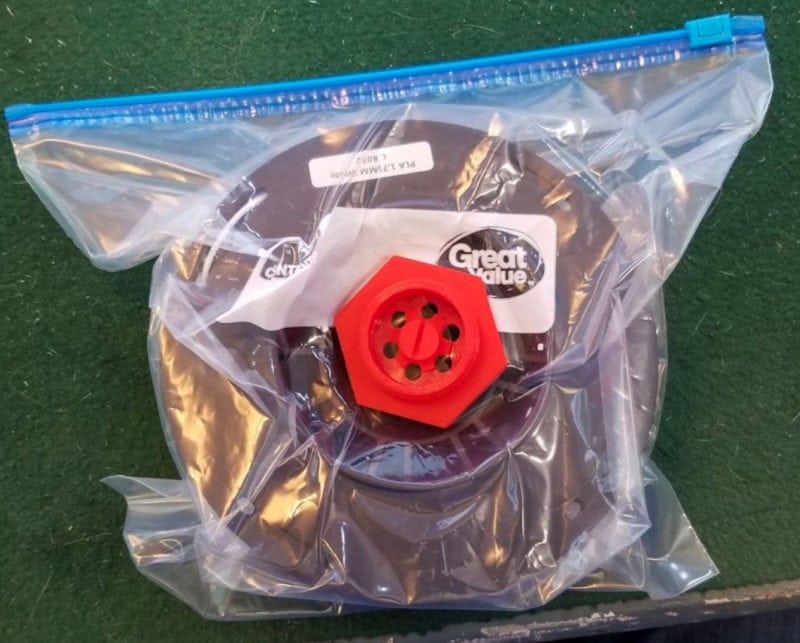
Plastic Storage Boxes
You can also use plastic crates or storage boxes as an easy way to store filament. This project used containers from IKEA to make an easy organizer for your filaments similar to the RepBox.
Other users built more sophisticated systems with outlets to send the filament to their printers, rollers to keep the filament feeding evenly, and a humidity gauge to keep track of the moisture levels within the container.
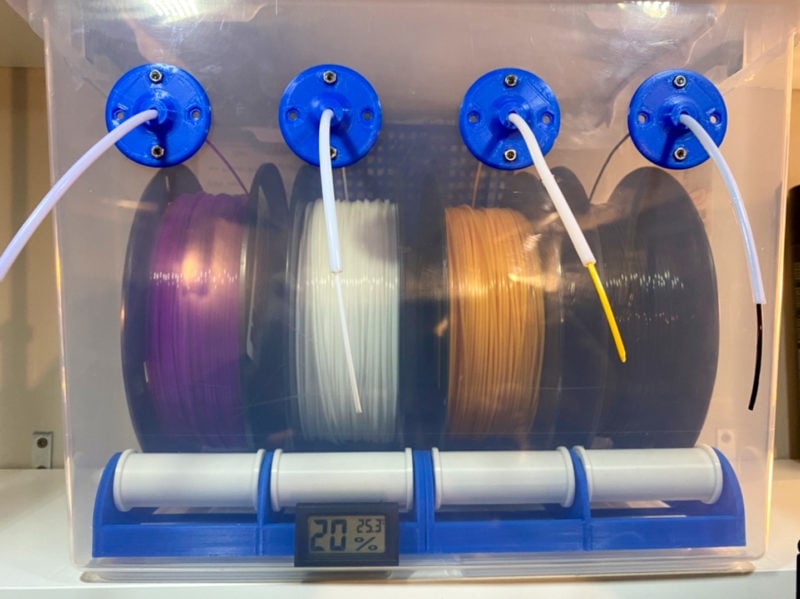
Interested in making your own dry box? We outlined how to make a similar project in our step-by-step tutorial, so go check it out!
Choosing the Best Filament Storage: What to Look for
Capacity
Consider how much filament you have open at one time. If you regularly switch between several different filaments, you would benefit from a large-capacity storage solution. If you tend to use only one or two rolls at a time, a smaller capacity is most likely sufficient.
Humidity
Humidity monitoring measures how much humidity is in the air, which is a useful feature to have in your filament storage solution. Knowing how high the humidity is inside your dry cabinets, storage boxes, etc. can help you ensure your filaments won’t absorb moisture from the air while in storage.
Price
While storage solutions for your 3D printing filament don’t have to be expensive, the more sophisticated product offerings can be. Advanced features like heating, temperature control, etc. are going to cost significantly more than a DIY or basic solution like a plastic bin and desiccant packet.
Built-In Heating/Drying
Having built-in heating and drying features ensure that your filament dries evenly and thoroughly. These solutions are great for not only preventing moisture in your filament spools but also making them usable again in the event that they do take on too much water.
Ease of Use
How easy and accessible your filament storage solution is to use can make a huge difference in your user experience. A storage solution that allows you to print directly from the container is more convenient than, say, vacuum-sealed bags that only protect the filament while it’s not in use.
How to Choose Desiccants for Filament Storage
Rechargeability
Reusable desiccants are a much more affordable solution to removing moisture from wherever you store filament than disposable varieties. Reusable desiccant can be placed in the oven, microwave, or food dehydrator to dry out and recharge each time it fills with too much moisture and can’t absorb any more. This will cut down on your waste if you require lots of desiccant to dry filament.
Color Indication
Some desiccants use color indication to let you know when it can no longer absorb water. This means that the beads will change color whenever they need to be dried out or replaced. This is a nice feature because it takes the guesswork out of knowing when to change the desiccant in your storage containers. That way, you won’t leave them in longer than you should and risk your filaments taking on too much moisture.
Amount
Consider how much desiccant you actually use. If you only use it occasionally, a small package of silica packets will probably do the trick. However, if you use a lot of it, bulk packaging and/or reusable desiccants will be much more affordable.
Packaging
Consider what sort of packaging you want your desiccant to come in. Bulk packaging is more economical but messier. Sometimes it comes with cloth bags to make your own packets. Disposable desiccant packets are cleaner and more convenient, but they tend to be more expensive.
Can I Leave PLA Filament in My 3D Printer?
How PLA filament is stored is an important consideration for filament quality. It’s best practice to store filament in a filament storage container when not in use. This will help keep the filament from absorbing moisture from the air and will help maintain its quality and printability.
Some enclosed 3D printers store their filament internally, preventing it from absorbing too much moisture from the ambient air.
How Do You Store Open 3D Filaments?
There are a few ways to store open 3D filaments. If the filament is brittle, it’s best to store it in a sealed container with a desiccant like rice or silica gel packs. If the filament is still flexible, you can coil it up and place it in a zip-lock bag or airtight container.
Does 3D Printer Filament Have a Shelf Life?
In general, 3D printer filament does not have a shelf life. However, the lifespan of the filament may be shortened if it is stored in a very humid or moist environment.
3D printer filament is made from thermoplastic polymers, which are materials that can be melted and molded into different shapes. The quality and performance of the filament may change over time if it is exposed to excessive heat, humidity, or moisture. For this reason, it is important to store the filament in a cool, dry place when not in use.
What Humidity Should 3D Filament Be Stored At?
Given that there are many different types and materials of 3D printer filament, there is no one-size-fits-all answer for this. In general, it is recommended to keep all filaments at least under 50% RH (Relative Humidity). For more specific numbers, it is best to check with the filament manufacturer.
What is a Filament Dry Box?
A filament dry box is a device used to store filaments for 3D printing. It maintains a consistent low humidity environment which prevents the filament from absorbing moisture from the air. Some filament dry boxes also include a heater, which helps reduce the humidity further and removes moisture from the filament itself.
Final Thoughts
It’s important to store filament for 3D printing in a way that protects it from moisture, since that can cause several quality issues with both your prints and your 3D printer during the 3D printing process. Nylon, PETG, and PLA filaments are especially sensitive to water and readily absorb it from the humidity in the air.
Using a storage solution with an airtight seal such as vacuum bags or storage boxes is key to keeping water from contaminating your filaments, but that won’t be enough if your filaments are already contaminated. You can dry your wet filaments with a dry cabinet, filament dryer, and even a food dehydrator.
Products like the Sovol SH01 Filament Dryer make this easy, because they allow you to store filament in its airtight chamber or dry it using its built-in heating element. These types of products are essential for keeping your filaments in good condition.
Are you still wondering about storage solutions for your 3D printing filament? Let us know what questions you have in the comments below!
